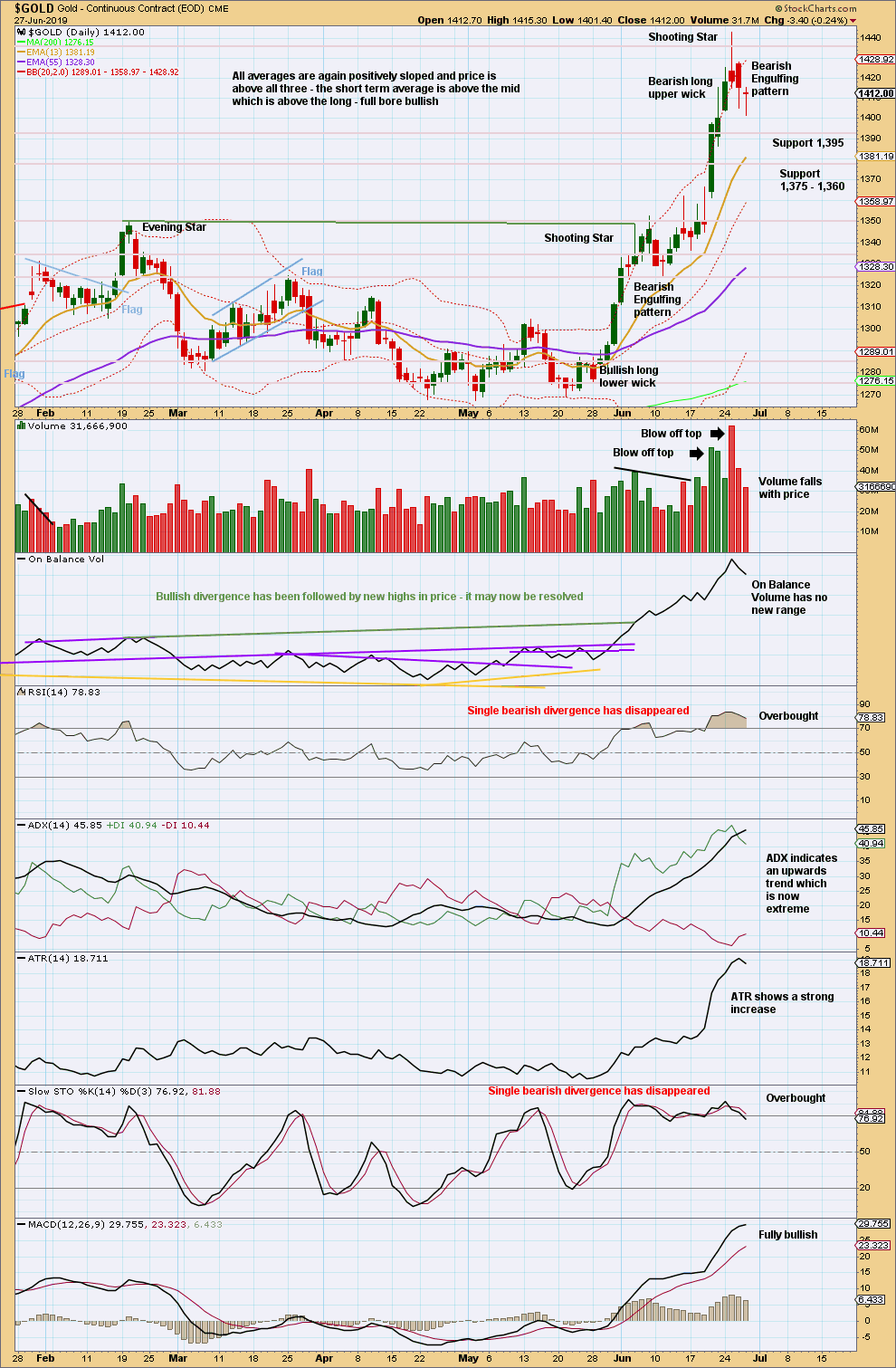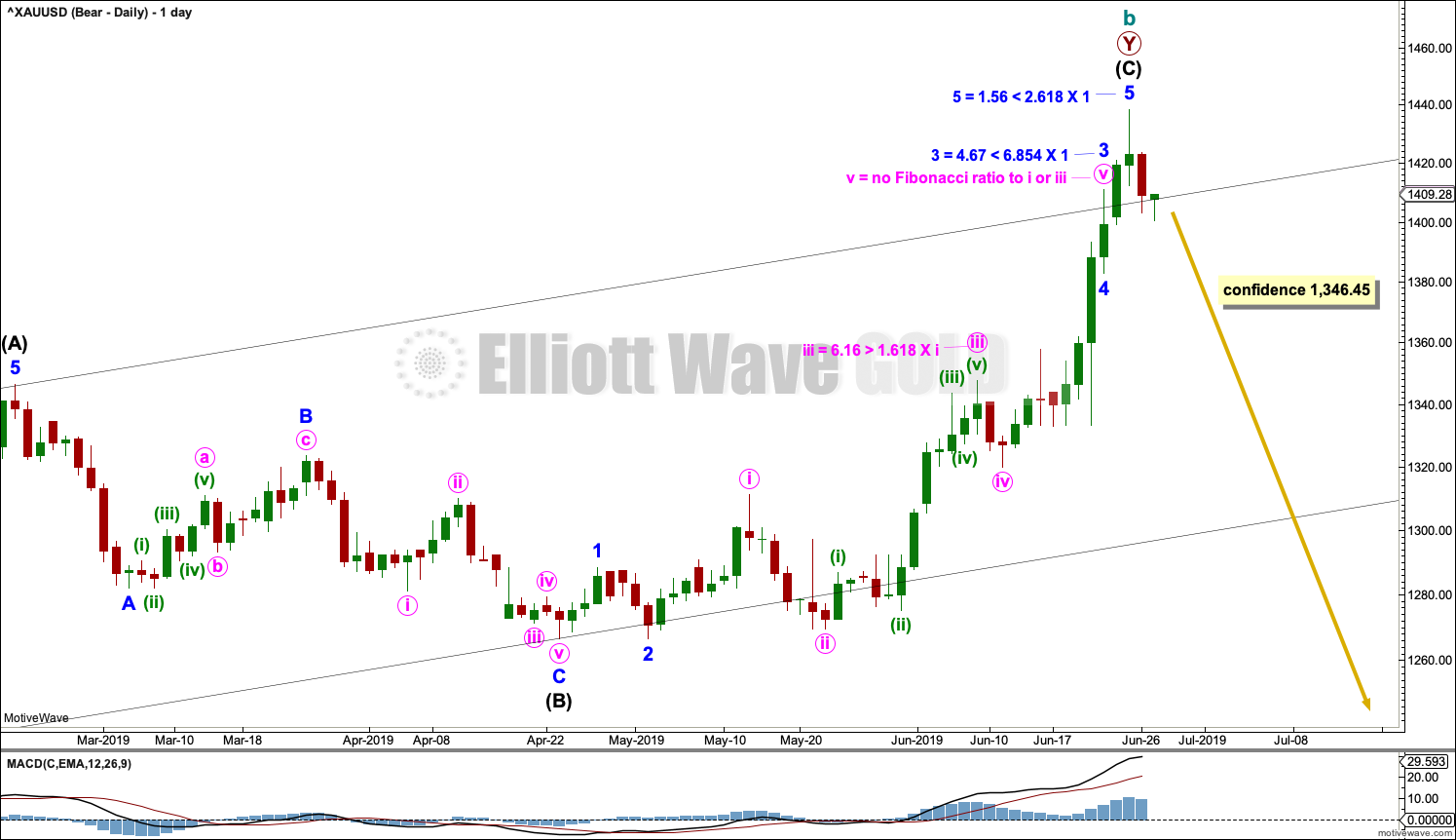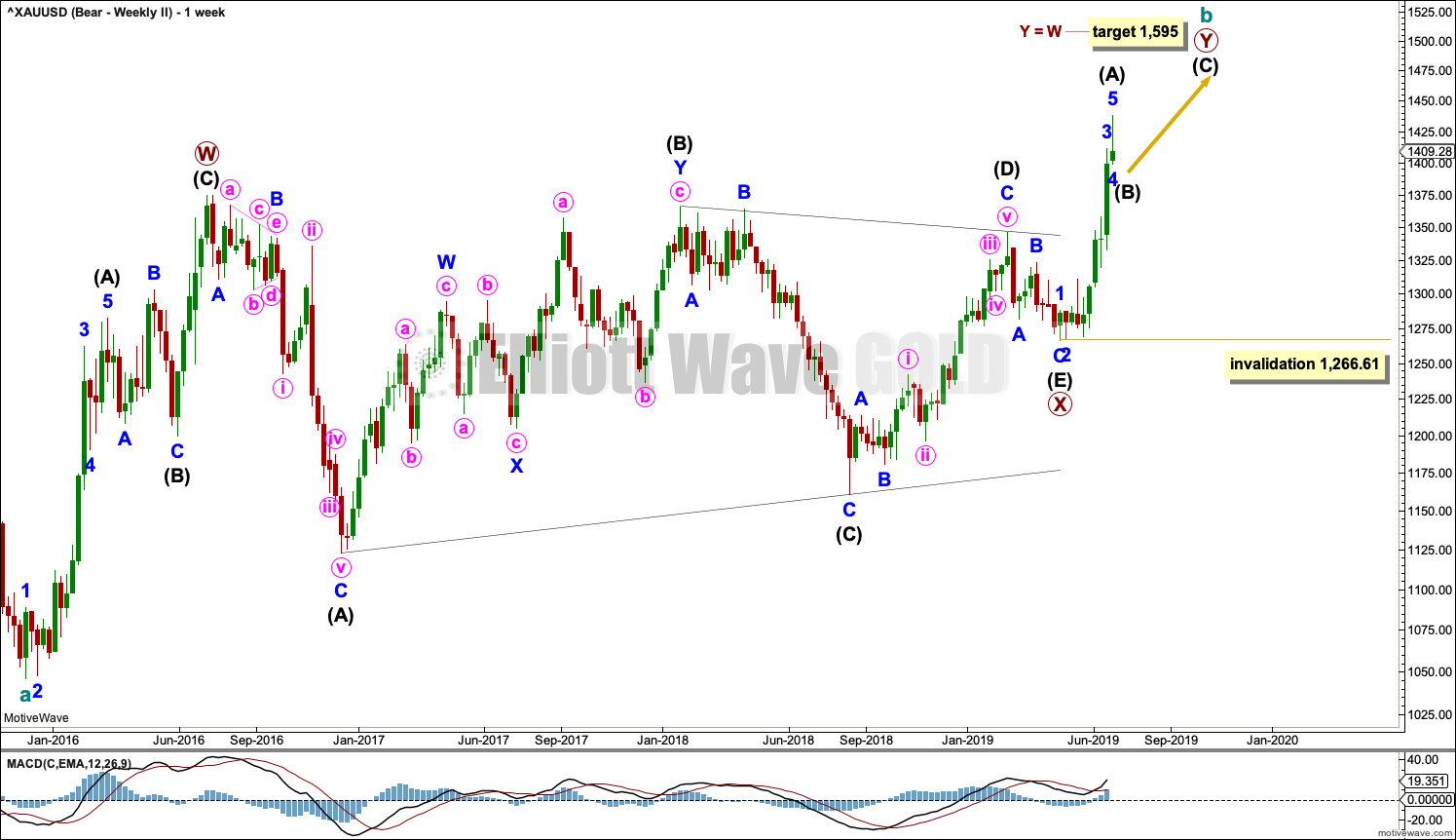More downwards movement fits the short-term expectation for both Elliott wave counts.
Summary: A high may now be in place earlier than expected for the bearish Elliott wave count. Price may continue higher towards 1,565 for the bullish Elliott wave count.
A new low by any amount at any time frame now below 1,346.45 would invalidate the bullish wave count and give confidence to the bearish wave count.
The bullish wave count has a long-term target at 1,693 for cycle wave III to end.
Grand SuperCycle analysis is here.
Last monthly charts are here. Video is here.
Overall, the bearish wave counts still have a higher probability based upon Elliott wave structures. However, it would be best to leave price to invalidate either the bullish or bearish scenario before having confidence in which is correct.
BEARISH ELLIOTT WAVE COUNTS
FIRST WEEKLY CHART
It remains possible that the bear market for Gold may yet continue when cycle wave b is complete, and it is possible that cycle wave b may be complete at the high. Cycle wave b may be a double zigzag.
Double zigzags are common structures, but within them their X waves are almost always single zigzags that are relatively brief and shallow. However, X waves may be any corrective structure, including a multiple.
The maximum number of corrective structures in a multiple is three. This count of three refers to W, Y and Z. To label any one of W, Y or Z as multiples violates this Elliott wave rule. However, X waves may be labelled as multiples and here the rule is met. X waves do occasionally subdivide as multiples.
This wave count sees primary wave X as a complete double combination: zigzag – X – expanded flat.
Primary wave Y may be a complete zigzag. The purpose of a second zigzag in a double zigzag is to deepen the correction when the first zigzag does not move price far enough. This purpose has been achieved.
A new low now by any amount at any time frame below 1,346.45 would invalidate the bullish wave count below and provide some confidence in this wave count.
DAILY CHART
This chart focusses on the impulse of intermediate wave (C).
Intermediate wave (C) may be a complete impulse; the structure may now be complete at all time frames. There is a bearish candlestick reversal pattern on StockCharts data.
This wave count now requires a new low below 1,346.45 for confidence.
HOURLY CHART
If there has been a trend change at cycle degree at the last high, then a five down should develop first on the hourly chart and then on the daily chart. The first five down is labelled minor wave 1, and it may now be complete.
A three up for minor wave 2 should develop. Minor wave 2 may not move beyond the start of minor wave 1 above 1,438.43.
The first second wave correction within a new trend for Gold is usually very deep. The 0.618 Fibonacci ratio as a target may not be high enough.
SECOND WEEKLY CHART
It is also possible that cycle wave b may be an incomplete double zigzag, with primary wave X within it a complete regular contracting triangle.
The most common point for E waves of Elliott wave triangles to end is to fall reasonably short of the A-C trend line. However, this example sees intermediate wave (E) too short of the (A)-(C) trend line for a normal look. This wave count is possible, but it has as reduced probability for this reason.
If primary wave Y begins at 1,266.61, then the target for it to reach equality in length with primary wave W is at 1,595.
BULLISH ELLIOTT WAVE COUNT
WEEKLY CHART
This wave count sees the the bear market complete at the last major low for Gold in November 2015.
If Gold is in a new bull market, then it should begin with a five wave structure upwards on the weekly chart. However, the biggest problem with this wave count is the structure labelled cycle wave I because this wave count must see it as a five wave structure, but it looks more like a three wave structure.
Commodities often exhibit swift strong fifth waves that force the fourth wave corrections coming just prior and just after to be more brief and shallow than their counterpart second waves. It is unusual for a commodity to exhibit a quick second wave and a more time consuming fourth wave, and this is how cycle wave I is labelled. This wave count still suffers from this very substantial problem, and for this reason two bearish wave counts are still considered above as they have a better fit in terms of Elliott wave structure.
Cycle wave II subdivides well as a double combination: zigzag – X – expanded flat.
Cycle wave III may have begun. Within cycle wave III, primary waves 1 and 2 may now be complete. If it continues lower as a double zigzag, then primary wave 2 may not move beyond the start of primary wave 1 below 1,160.75.
Cycle wave III so far for this wave count would have been underway now for 45 weeks. It may be beginning to exhibit some support from volume and increasing ATR. If this increase continues, then this wave count would have some support from technical analysis.
Draw an acceleration channel about primary waves 1 and 2: draw the first trend line from the end of primary wave 1 to the last high, then place a parallel copy on the end of primary wave 2. Keep redrawing the channel as price continues higher. When primary wave 3 is complete, then this channel would be drawn using Elliott’s first technique about the impulse. The lower edge may provide support.
Primary wave 4 may not move into primary wave 1 price territory below 1,346.45.
DAILY CHART
This daily chart focusses on the impulse of primary wave 3.
Primary wave 3 may only subdivide as an impulse. Primary wave 3 has now moved above the end of primary wave 1, meeting a core Elliott wave rule.
When it arrives, primary wave 4 may not move into primary wave 1 price territory below 1,346.45.
Intermediate wave (5) may exhibit further strength. The target for primary wave 3 is calculated using the most common Fibonacci ratio to primary wave 1.
HOURLY CHART
Intermediate wave (4) may still be unfolding, and it may not move into intermediate wave (1) price territory below 1,346.45.
Intermediate wave (4) may be an incomplete double zigzag, which is a fairly common corrective structure. The purpose of the second zigzag in the double is to continue the correction when the first zigzag does not move price far enough. The target would see this purpose achieved.
Within minor wave Y, minute wave b may not move beyond the start of minute wave a above 1,415.03.
At this stage, a new high above 1,415.03 would indicate that intermediate wave (4) would fairly likely be over.
TECHNICAL ANALYSIS
MONTHLY CHART

Click chart to enlarge. Chart courtesy of StockCharts.com.
Gold has effected an upwards breakout above multi-year resistance and above the cyan bear market trend line. Look for next resistance identified on the chart.
WEEKLY CHART

Click chart to enlarge. Chart courtesy of StockCharts.com.
Gold has broken out of a multi-year consolidation, which saw resistance about 1,375. The breakout has support from volume, so confidence may be had in it.
Price now has some strength with rising ATR. Conditions are overbought and On Balance Volume is at resistance. A pullback or consolidation may begin here before the upwards trend resumes.
Look now for strong support about 1,375 for a possible back test.
DAILY CHART

Click chart to enlarge. Chart courtesy of StockCharts.com.
After the upwards breakout, it would be typical to see price curve back down to test support at prior resistance. Extreme overbought conditions may be relieved by a back test.
There are now two bearish candlestick reversal patterns. Look in the first instance for a test of support about 1,395 and below that about 1,375. The Doji today does not change the expectation of a back test to continue.
GDX WEEKLY CHART

Click chart to enlarge. Chart courtesy of StockCharts.com.
The upwards trend continues. A close near the high for the week suggests more upwards movement this week.
GDX DAILY CHART

Click chart to enlarge. Chart courtesy of StockCharts.com.
The last gap is closed, so it is now renamed an exhaustion gap. This indicates the possibility of a trend change. In conjunction with a bearish candlestick reversal pattern in the Dark Cloud Cover, a trend change here may be reasonably likely.
Published @ 06:13 p.m. EST.
—
Careful risk management protects your trading account(s).
Follow my two Golden Rules:
1. Always trade with stops.
2. Risk only 1-5% of equity on any one trade.
—
New updates to this analysis are in bold.








Updated hourly chart for the bearish wave count:
For now this will be the wave count. I will consider the bullish / bearish case for the short to mid term when I have end of week data. I may adjust the bearish wave count if it looks like upwards movement is not over, it may need one more high.
Lets see what the technicals say.
Hi Lara,
Is it possible that intermediate wave 4 is a triangle for the bullish count? Would technical analysis and having a 5 wave down allow for that possibility?
it could have been a double zigzag down, if so, then a triangle for intermediate (4) to continue sideways works for the bull wave count